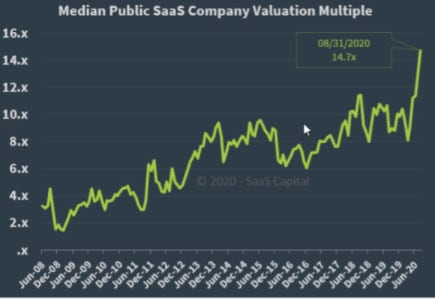Have you ever read an article in the Wall Street Journal about a company that just went public and thought to yourself: “How is that company worth that much?” Or, have you ever wrapped up a hard quarter and wondered: “Did all this effort actually make my business more valuable?”
For owners and senior managers of small and midsize businesses, these are not idle questions. If you’re considering a capital infusion to fund growth, or an acquisition to accelerate it, you want to know how the market arrived at those other company valuations so you can use the same technique to determine what your business—or your acquisition target—is really worth.
The good news is there’s a fast-and-simple financial analysis—valuation multiples—that can help. All you need is some basic math, which we’ll get to in a minute, along with the application of straightforward valuation principles.
At least you’ll know how the market arrived at that valuation, even if you don’t agree with it.
Key Takeaways:
- Valuation multiples represent the ratio of one business metric to the estimated value or, for public companies, market value of a business.
- Benchmark multiples from different industries can be used to estimate any business’s value, as long as you know the business’s metrics.
- Most commonly used multiples are related to a company’s sales, earnings or assets.
- It’s important to choose the right multiple to get a good valuation estimate and to make sure the benchmark you use is based on companies very similar to the one you’re valuing.
What Are Valuation Multiples?
The concept behind valuation multiples is that the market value of a business can be calculated based on the ratio of one or more key business metrics to the known values of companies similar to the one you’re valuing. While business leaders point out that no single metric completely reflects the totality of a business, there are many such metrics that businesses can incorporate into a valuation multiples analysis. Some are more applicable in one industry, or one type of company, than another. Calculating several of these different ratios can give you a strong directional sense of a business’s value.
Valuation Multiples Explained
The first thing you need to know to use valuation multiples is a little basic math. The numerator of the fractions involved in valuation multiples is always a business value. An example is the share price in the best-known multiple of all, the price-to-earnings (PE) ratio, which is simply the ratio of the company’s earnings per share (EPS) to its share price.
Valuation Multiples Formula
The denominator is the business metric you’re focusing on for a given analysis—the earnings in a PE ratio. You transform that PE ratio into a “multiple” you can use in valuation analyses by multiplying both sides of that simple equation by the business metric to get this new equation: Business Value = Business Metric x the Multiple.
Numerator / Denominator = Ratio = Business Value / Business Metric = Multiple
Let’s do the math with a real-life example. On June 30, 2020, Charles Schwab shares closed at $33.56, and its EPS was $2.38, for a PE ratio of 14.10. If you put those numbers into the equation above, it looks like this:
$33.56 = $2.38 x 14.10
Schwab had 1.29 billion shares outstanding in September 2020, so its total valuation—that is, market capitalisation—was $33.56 x 1.29 billion, or $43.3 billion.
Applying Valuation Multiple to Decisions
Valuation analysis isn’t a one to one comparison, so to estimate the valuation you would calculate a given multiple for several similar business and find the median or mean value for all of those companies. Then compare that value to the same multiple for a given business.
Business metrics like the PE ratio are published for public companies across all industries. Sometimes the metric can be one number from a financial statement, for example, revenue, or EBITDA, and sometimes it’s also a calculated number, like a growth rate. Regardless, once you know a metric for a company you’re interested in, you can look up the benchmark ratios of that metric to company valuations for that industry and multiply the ratio times the metric to arrive at an estimated value for the business.
Owners of small or midsize private companies can get a beginning estimate of their company’s valuation by multiplying one or more of their metrics times the appropriate publicly known benchmark ratio.
What Are the Different Types of Valuation Multiples?
There are different types of valuation multiples simply because there are different ways you can calculate value. For example, if the company is publicly traded, you can look at its stock price times the number of shares available, which equals its market cap. However, that ignores critical information, like the amount of cash and debt on the company’s balance sheet. That’s where knowing a company’s enterprise value is handy.
Sometimes, though, the value is just a number that has been set by independent financial experts with insights into the market. This is particularly useful for private companies that don’t constantly have Wall Street valuing their business all day, every day, when the stock market is open. The two examples below illustrate this well.
Example: Valuing a High-Growth Startup
As high-growth startups raise late-stage venture capital, you can often go back and see what the startup was valued at before it received funding, then track its multiples through subsequent funding rounds. At every single round, the company sells a fraction of itself, so depending on what it raises, you have a new value for the company at each round. Say the company is selling 5% of its business, and an investor is willing to pay $20 million. That yields a $400 million valuation: $20 million / 0.05 = $400 million.
Investors can use this data to project valuations for similar businesses.
One popular example for software as a service (SaaS) businesses comes from lender SaaS Capital. The firm regularly updates its SaaS Capital Index to look at the average current revenue run-rate multiple relative to a cohort of public company SaaS valuations. “Run rate” refers to the practice of extrapolating current financial results to predict future values.
The most recent update shows valuation equal to a median multiple of 14.7 times run-rate revenue. As the chart below shows, this valuation multiple has evolved over time.

In Q1, SaaS Capital proposed a 28% discount for valuing private instead of public companies. If you apply that 28% discount to the 14.7 multiple, you end up with a 10.6 multiple:
14.7x – (28% of 14.7) = 10.6x
Using this approach, a private SaaS business with a $10 million revenue run-rate would be worth $106 million, based on this multiple.
One note of caution: It’s really important to make sure comparisons are accurate. Unfortunately, many entrepreneurs are overly optimistic when thinking about what the “right” comparable companies are for their businesses, or they don’t dig in to see where the comp companies’ revenue is coming from. Going back to our SaaS example with the $10 million run-rate, if some of that revenue was not recurring SaaS revenue, for example, then you shouldn’t apply the same multiple to that nonrecurring portion of revenue.
Example: Valuing Comparable M&A Transactions
Sometimes the measure of value is what another acquirer paid for a similar business. This data allows a company’s board to project what the business would be worth if approached by similar buyers. Two notes of caution:
- First, not all buyers are going to value a business the same way. As an oversimplification, financial buyers seeking an investment will pay less than acquirers who are looking to buy a business for strategic purposes, such as a manufacturer looking to fill in a gap in its product line or a retailer reaching a different demographic.
- Second, keep in mind that often, beyond the metrics, there can be other considerations factoring into any given acquisition valuation—so if you pick the wrong metric to focus on, all you get is noise.
Different Types of Business Metrics
This leads to the more important decision for business leaders focused on leveraging valuation multiples: which type of business metrics to focus on. While some industries have very specific business metrics that are most relevant, in general, picking the right metric typically comes down to three choices.
Choice 1: Valuing Revenue vs Profit
Most leaders need to decide if they should focus more on revenue or profitability. In general, companies earlier in their development prioritise top-line revenue, while more mature businesses focus on profit and unit margins. There are certainly exceptions to this rule. A well-cited example is Amazon.com, which has relatively low profits compared to revenue, but has grown into one of the most valuable companies in the world primarily based on revenue—or, more specifically, revenue growth rate.
If a company is being valued based on revenue, it’s important that there is a credible narrative about how it will—eventually—become profitable. This is where the gross margins for specific products become important, because this data can be used as the metric in valuation multiples analyses.
Even if the company is investing that gross margin back into the business to further accelerate growth, it’s important that a company’s products or services have decent gross margins as it starts to scale. Otherwise, the firm may end up in a situation many growth equity firms describe as “profitless prosperity.”
Choice 2: Valuing Historical Results vs Forecasts
Another important consideration: Are you using historical results or forecasts? There are advantages and disadvantages to both approaches. Historical results are, by definition, much more precise and accurate. They also ensure that, if you are comparing different companies' results, you don’t have varying “levels of optimism” baked into the numbers, as can happen with financial forecasts.
However, given that the value of a company is fundamentally much more about future profits than it is about the current or past state of the business, if forecasts can be done accurately and both sides can agree on the conclusions, they’re generally more helpful.
Choice 3: Current Results vs Growth Rate
The debate between historical results and forecasts also leads to a related point: In some cases, it becomes difficult to agree on which forecast to use. However, in situations where the past can credibly be argued as directionally predictive of the future, one helpful approach is to use the company’s growth rate. Growth rate is typically used in combination with current results.
#1 Cloud
Accounting
Software
Common Formulas for Calculating Valuation Multiples
Now that we’ve walked through these conceptual choices, here’s a set of common formulas used to calculate valuation multiples based on either a company’s revenue or its profit.
Revenue-based formulas: If you want to focus on revenue, the two most common formulas you’ll hear about are “EV to Revenue” and “Price to Sales.” In both of these cases, you’re focused on top-line revenue, not profit. The big difference is whether you use the company's market cap (price) or enterprise value (EV). You’ll sometimes hear these referred to as “EV to Sales” or “Price to Revenue.” In other words, sales and revenue are synonymous.
Profit-based formulas: Alternatively, profit, or what is typically described in these ratios as “earnings,” are the area of emphasis. Similar to above, profit-based multiples formulas can also focus on market cap (price) or EV. One common example, “Price to EPS,” focuses on earnings per share, and is simply share price divided by EPS. In this case, because earnings are being divided by the number of outstanding shares, you can use share price instead of market cap in the numerator as the measure of value. This is the exact same thing as taking market cap and dividing it by total company earnings.
A company’s growth history is one metric that will influence its value. For example, a company that’s consistently growing at 10% a year might justify a higher valuation than a company with similar earnings that’s growing at 4%. You’ll often hear analysts talk about a company’s “PEG ratio,” which stands for a company’s price-to-earnings growth rate. A PEG ratio is calculated as PE ratio in the numerator and EPS growth — typically over one to three years — in the denominator.
There also are valuation multiples that focus on different ways profit or earnings can be calculated. Sometimes it’s helpful to look at EBITDA (earnings before interest, taxes, depreciation and amortisation). You’ll often hear analysts talk about a company’s EV to EBITDA ratio.
How to Use Valuation Multiples to Compare Companies
Books have been written and MBA courses offered on this topic. But here are a few things to keep in mind when comparing companies using valuation multiples:
- Make sure you’re calculating the multiple the same across companies. For example, if one company’s analysis uses forward-looking projections and the second uses historical data, you won’t be able to draw any reasonable conclusions. Similarly, if one valuation multiple is using EBITDA for earnings, make sure the other is as well.
- Whenever possible, evaluate companies using a variety of multiples. The common formulas described above drive at different business principles. If the companies are actually comparable—for example, they’re in the same industry—then it’s helpful to compare across a few multiples.
If your company is seeking funding, ensure you have a handle on your value and can discuss the method by which you determined that number, how well you met previous projections and why your forward-looking revenue scenarios are solid.
Why Are Valuation Multiples Different for Different Industries?
First of all, different industries have different profit margins and operating models. As an easy example, manufacturing firms and software companies typically have very different margins. Therefore, a multiple focused on top-line revenue is not that helpful when comparing companies across those two industries.
Different markets also have different growth rates. And sometimes, growth rates can get very granular. For example, most retail industry analysts forecast different growth rates for in-store commerce vs ecommerce. Therefore, different multiples for different retailers are common. Obviously, individual sectors within retail may also have different growth forecasts.
Why Do Valuation Multiples Matter for Your Business?
Valuation multiples can give you a sense of how similar businesses compare in value. This can help your team understand a number of things, including:
- What is our business currently worth?
- What adjustments can we make to increase its value?
- What is a fair price for another business?
- How do current valuations relate to historical periods?
It’s important to choose the right multiple to get a good valuation estimate and to make sure the benchmark you use is based on companies very similar to the one you’re valuing.









